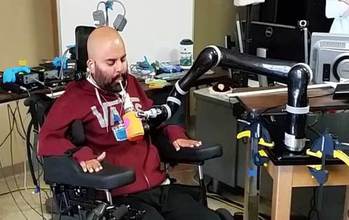Multimedia Gallery
Research will generate a new approach to using brain signals to control intelligent robotic systems.
Brain-machine interfaces read signals directly from the brain to control external devices such as robotic limbs. While this technology has great potential to benefit people who are paralyzed, the interfaces often have poor performance because they use low-level signals to simultaneously control many aspects of the robotic limb's movements. New NSF-funded research will leverage expertise across diverse fields to generate significant improvements in brain-machine interface technology. Shown here is Erik Sorto using a brain-controlled robotic arm to take a drink.
Credit: Spencer Kellis and Christian Klaes
Images credited to the National Science Foundation, a federal agency, are in the public domain. The images were created by employees of the United States Government as part of their official duties or prepared by contractors as "works for hire" for NSF. You may freely use NSF-credited images and, at your discretion, credit NSF with a "Courtesy: National Science Foundation" notation.
Additional information about general usage can be found in Conditions.
Also Available:
Download the high-resolution JPG version of the image. (81.0 KB)
Use your mouse to right-click (Mac users may need to Ctrl-click) the link above and choose the option that will save the file or target to your computer.
Related story: Bold new brain research in neuroengineering, brain-inspired design, and individuality



